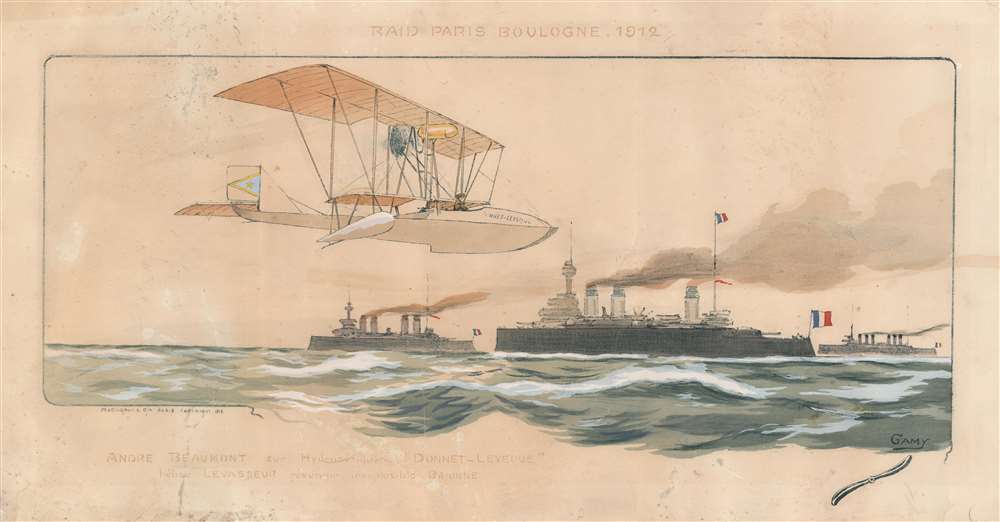1912 Gamy Pochoir View of a Hydro Airplane Over the English Channel
RaidParisBoulogne-gamy-1912
Title
1912 (dated) 15.75 x 30 in (40.005 x 76.2 cm)
Description
Beaumont's Flight
On August 9-10, 1912, Beaumont, a well-known aviation pioneer, flew a Donnet-Lévêque from Paris along the Seine River to Le Havre and then followed the coastline to Boulogne-sur-Mer. The flight was promoted in the French magazine La Vie au Grand Air, with photographs of the flight and a portrait of Beaumont occupying several pages.André Beaumont
André Beaumont (February 8, 1880 - August 11, 1937), the pseudonym of Jean Louis Conneau, was a French aviation pioneer. He earned a diploma from the École Supérieure d'Aéronautique in 1910, the same year he received his civil pilot's license from the Blériot flying school. In 1911, Beaumont made his name by winning Europe's three most rigorous aeronautical contests. He won the race from Paris to Rome (1,465 kilometers) in May. Then he won the first Circuit d'Europe (Tour of Europe: Paris-Liege-Spa-Utrecht-Brussels-Calais-London-Calais-Paris) in June in a Blériot monoplane. Of the 40 aviators who participated in the Circuit d'Europe, only 9 finished. Finally, he won the Round Britain Race through England and Scotland in July. He was named technical director at seaplane manufacturer Donnet-Lévêque in June 1912. In 1913, he co-founded Franco-British Aviation, an aircraft manufacturer that specialized in building flying boats.Pochoir
Pochoir is an artistic printing process that combines various styles, including lithography, photography, and engraving. It begins with a découpeur, who studies the original piece meant to be reproduced, analyzing the range of colors. Then, the découpeur creates stencils (between eight and fifteen for basic works and more than forty for complex compositions) from materials such as copper, aluminum, or zinc. The stencils were then passed to coloristes who applied watercolors or gouache in layers. Given the idiosyncrasies of coloristes, even down to the strength of brush strokes, no two pochoirs are identical.Publication History and Census
This view was created by Marguerite 'Gamy' Montaut and published by Mabileau and Company in 1912. While this piece is not cataloged in OCLC and does not appear to be part of any institutional collections, it does appear on the market from time to time.Cartographer
Marguerite 'Gamy' Montaut (1883 - 1936) was a French artist who signed her work 'Gamy' and most of her work was produced using the pochoir process. She and her husband Ernest Montaut (1879 - 1909) created works of art focusing on the early transportation. Ernest Montaut began producing work in the early 1890s. Marguerite produced work focusing on not only auto racing but also early aviation. Marguerite is credited with the innovation of using lines behind vehicles to indicate speed, along with elongating parts of the vehicle to do so as well. She continued producing work after her husband's death in 1909. 'Gamy' is believed to be an anagram for 'Magy'. More by this mapmaker...

